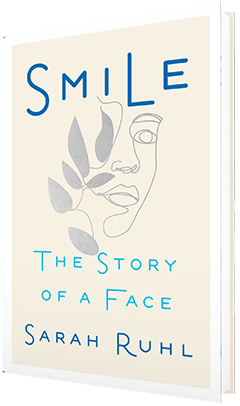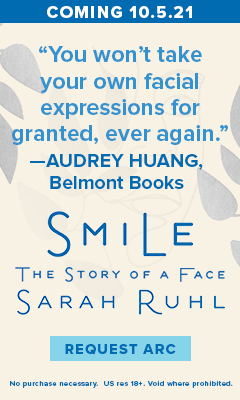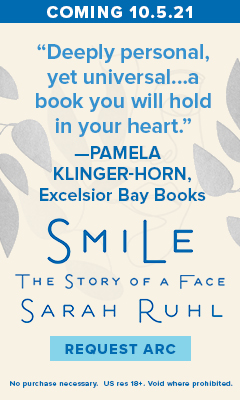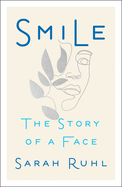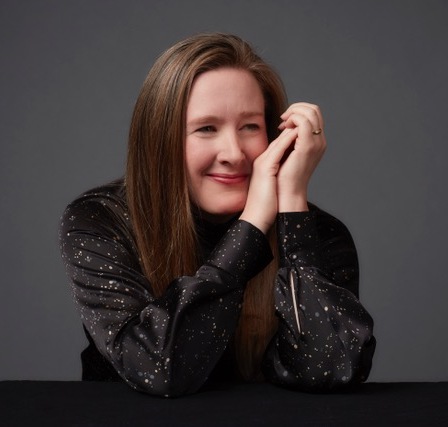Smile: The Story of a Face
by Sarah Ruhl
After giving birth to twins, playwright Sarah Ruhl (Dear Elizabeth; How to Transcend a Happy Marriage) found herself unable to smile--or even to move the left side of her face. Ruhl soon discovered she had Bell's palsy, a condition characterized by muscle droop and weakness on one side of the face. In her sharply observed memoir, Smile: The Story of a Face, Ruhl chronicles her decade-long experience with Bell's palsy, and the disease's emotional implications for the rest of her life.
Like many mothers, Ruhl was focused on her babies during labor and delivery, especially when both twins had to spend a week in the NICU (Neonatal Intensive Care Unit). But while she was still in the maternity ward, she realized she couldn't close her left eye, or move the muscles on that side of her face. After bringing home both children and adjusting to her newly expanded family (which included an older daughter), Ruhl expected that her Bell's palsy would gradually disappear. It didn't. "In fairy tale logic," she writes, "you must trade something for something you desire. By this logic, I trade my face for my children. And it is a fair trade." But the longer the malady lingered, the more Ruhl began to wonder if her affliction wasn't a simple trade, but a symptom--or an effect--of something deeper.
Born and raised in the Midwest, Ruhl grew up smiling without a second thought at both friends and strangers. "They hand [smiles] out along with lollipops at the bank," she writes of her native Illinois. "Nice, big, broad untroubled smiles that you have to undo when you move to New York City." Although Ruhl had long since adapted to the more reserved style of living and socializing in New York, her work in the theater world meant that she interacted regularly with dozens of people--actors, directors, production staff--for whom affect (theirs and hers) was supremely important. Being unable to smile at hopeful auditionees, colleagues and friends was bad enough, but Ruhl worried constantly about her children. Would they still understand that she loved them, even though she couldn't form expressions of delight? Would her half-frozen face somehow stunt their emotional growth during their formative years? Ruhl meditates on these and other questions in Smile, while also charting her attempts to find a "fix" for her Bell's palsy. She tries a long list of possibilities--acupuncture, Alexander technique, physical therapy, even neurosurgery.
As a playwright and a woman, Ruhl is keenly aware that cultural myths and mores around smiling differ greatly for women and men. She muses on the ways women are perceived--as angry, detached, even lacking in emotional intelligence--if they don't smile when it is expected of them. She considers the role of smiling in pieces of art, from the Mona Lisa to her own plays, and the ways in which smiling has a chicken-and-egg effect on one's emotions. "I felt inside a paradox," she writes. "I thought I could not truly re-enter the world until I could smile again; and yet, how could I be happy enough to smile again when I couldn't re-enter the world?"
As her children grow and her face remains frozen, Ruhl eventually finds ways to move on with the rest of her life: teaching, staging new plays, mothering her children, publishing a book of essays drafted mostly on Amtrak train rides. She is candid about the constant juggling act of being a woman with a career and a family, and also about the added layer of difficulty caused by partial facial paralysis. It isn't all doom and gloom: she takes great joy in her children and husband, and deep satisfaction in her work. But she wants her face--or at least her freedom of expression--back.
It takes a long time, in the book and in Ruhl's life, for her face to reemerge, even partially, from its half-frozen state. "The partial recovery is not terribly dramatic. It is the stuff of life, not art. But the partial recovery is, I believe, very much like life. Most people have partially recovered from something." But in her honest account of life with Bell's palsy, Ruhl has managed to turn her partial recovery into a kind of art: a portrait of a face, and a body, sometimes at odds with the soul inside. Even readers who have never suffered a serious physical injury will recognize that disconnect: the sense that the body and spirit are not always in sync. Ruhl captures this disconnect with honesty, grace and frequent flashes of wry humor, without always needing to wrap everything up into a tidy insight. Smile is at once an illness narrative, a meditation on smiling as cultural practice and symbol, and a compelling, behind-the-scenes look at the life of a playwright and mother. --Katie Noah Gibson



